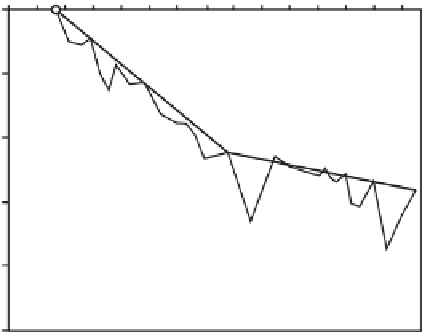Geology Reference
In-Depth Information
The diffi culty of disentangling eustasy and
tectonic subsidence in single locations, however,
does open the possibility that the Cincinnati Arch
may have experienced some uplift, particularly
in the northern Nashville Dome region, but that
this uplift was combined with a somewhat larger
rate of eustatic rise to produce a net slow posit-
ive rate of accommodation. The truncated record
of the C2-C4 sequences on the southern Nashville
Dome more strongly suggests uplift.
Age (Ma)
455
450
445
0
50
100
Nashville
150
Thrusting event
at base of Martinsburg
200
DISCUSSION
Jessamine
250
Comparison to fl exural models
M o h a w k i a n
C i n c i n n a t i a n
Turinian
Chatfieldian
Edenian
Maysvillian
Richmondian
G
Based on viscoelastic and elastic modelling of
foreland basin stratigraphy, a peripheral bulge
should migrate towards the craton as the orogenic
load advances onto the continent (Quinlan &
Beaumont, 1984; Flemings & Jordan, 1989,
1990; Jordan & Flemings, 1991; Dorobek, 1995).
Furthermore, viscoelastic models predict that the
peripheral bulge should move toward the thrust
load and the foredeep should deepen as loading
is 'relaxed'. The Taconic foreland basin has been
interpreted to record such a viscoelastic response
to loading (Quinlan & Beaumont, 1984; Tankard,
1986; Beaumont
et al
., 1988; Ettensohn, 1991,
1992, 1994). However, if the Cincinnati Arch was
a peripheral bulge, it appears that its position did
not migrate during the Late Ordovician. Instead, it
appears to have been a relatively fi xed, or static,
feature throughout the Taconic Orogeny.
Additionally, the boundaries for many of these
features (e.g. the Jessamine Dome, Sebree Trough)
are fi xed and clearly associated with faults
(Ettensohn, 1992; Kolata
et al
., 2001; Ettensohn
et al
., 2002).
M1
M2
M3
M4
M5
M6
C1
C2
C3
C4
C5
C6
Fig. 8.
Accommodation histories generated by backstrip-
ping analysis of sections from the northern Nashville
Dome and from the central Jessamine Dome. Long-term
patterns are thought to refl ect primarily subsidence his-
tories, whereas short-term patterns (< 1 Myr) are thought to
refl ect eustasy.
Through the M6 sequence, the Jessamine and
northern Nashville Domes have comparable
subsidence rates, suggesting that these regions
were undergoing moderate subsidence, although
it is possible that this history actually refl ects
slow long-term eustatic rise. Beginning in the
C1 sequence, however, the subsidence histories
of these two regions began to diverge. Although
subsidence rates on the Jessamine Dome are only
slightly lower than before, those on the northern
Nashville Dome underwent a fourfold decrease.
This pattern of relatively faster subsidence rates
to the north along the Cincinnati Arch is true even
north of the Jessamine Dome, where Cincinnatian
strata in southwestern Ohio and southeast-
ern Indiana are 40% thicker than those on the
Jessamine Dome. Likewise, the pattern of slower
subsidence rates to the south is consistent with
the erosional loss of the C2-C4 sequences before
C5 deposition on the southern Nashville Dome.
This change in subsidence rates is notable in that
it does not coincide with the onset of the Taconic
phase early in the M5, but is initiated 2-3 Myr
later in the Edenian Stage (C1).
These subsidence histories, combined with the
lack of any long-duration unconformities, sug-
gest that the Jessamine and Nashville Domes were
slowly subsiding features throughout the Late
Ordovician, rather than actively uplifting features.
Scale issues
The width of the preserved Taconic foreland
basin is ~200-300 km, from the western edge of
its thrust front to the eastern edge of the peri-
pheral bulge (Fig. 2). Undoubtedly, the width of
the Taconic foreland basin was probably larger
during deposition due to subsequent shorten-
ing during thrusting, however, according to
equation (4) the peripheral bulge for a basin of this
width should be ~ 250-400 km wide. However, all
shallow-water features in the Upper Ordovician
along the Cincinnati Arch occur within an area
less than 150 km in width (Figs 4, 6 and 7).


























